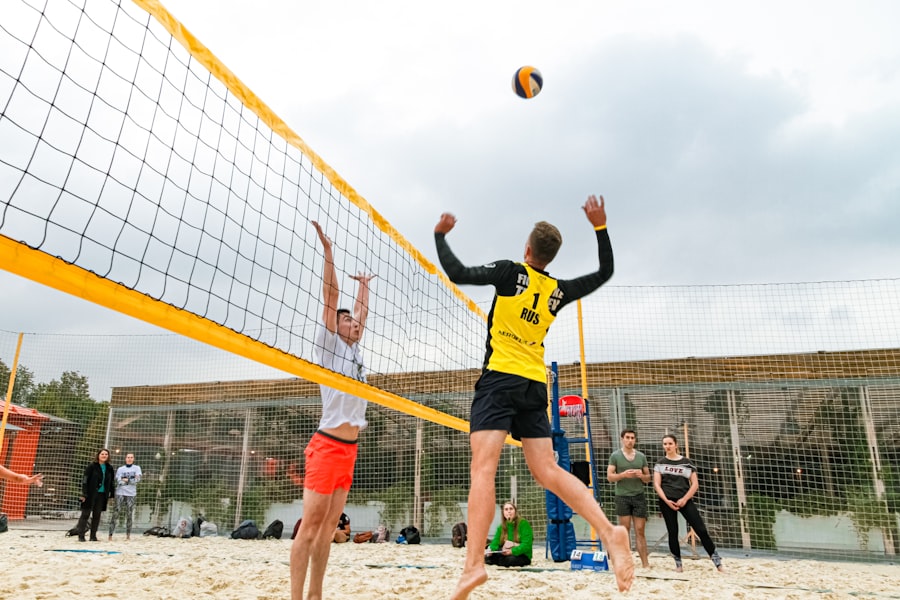Download links
How to install Mastering the Art of Volleyball: Tips for Success APK?
1. Tap the downloaded Mastering the Art of Volleyball: Tips for Success APK file.
2. Touch install.
3. Follow the steps on the screen.
Description
Volleyball is a dynamic sport that combines elements of strategy, athleticism, and teamwork. At its core, the game is played between two teams, each consisting of six players, who aim to score points by sending a ball over a net and into the opposing team’s court. The fundamental objective is to ground the ball on the opponent’s side while preventing them from doing the same.
The game is played in sets, with teams needing to reach a predetermined number of points, typically 25, to win a set, and the match is usually played in a best-of-five format. The court dimensions are crucial to understanding the game. A standard volleyball court measures 18 meters long and 9 meters wide, divided by a net that stands at a height of 2.43 meters for men and 2.24 meters for women.
Each side of the court is further divided into front and back rows, which play significant roles in both offensive and defensive strategies. The rotation system is another fundamental aspect; players must rotate positions after winning the serve from the opposing team, ensuring that all players participate in both offensive and defensive plays. This rotation not only keeps the game dynamic but also allows players to develop a well-rounded skill set.
Key Takeaways
- Understanding the basic fundamentals of volleyball is crucial for mastering the game.
- Developing essential skills such as serving, passing, and setting is key to becoming a well-rounded player.
- Mastering the art of spiking requires techniques for powerful and accurate hits.
- Improving defensive strategies like digging and blocking is essential for a strong defense.
- Teamwork and communication are essential elements for success in volleyball.
Developing Essential Skills: Serving, Passing, and Setting
Serving Techniques and Strategies
There are various types of serves, including the underhand serve, overhand serve, and jump serve. The overhand serve is particularly effective as it allows for greater speed and placement, making it harder for opponents to receive. Practicing consistent serving techniques can significantly impact a player’s ability to control the game from the outset.
Passing: The Key to a Strong Defense
Passing, often referred to as “bumping,” is another fundamental skill that requires precision and timing. A well-executed pass can set up an effective attack, while a poor pass can lead to missed opportunities. Players must learn to position themselves correctly to receive serves or attacks from opponents. The forearm pass is commonly used for receiving serves, while overhead passing techniques are employed for setting up attacks.
Setting: The Playmaker of the Team
Mastering these techniques involves not only individual practice but also working with teammates to develop chemistry and timing. Setting is the third essential skill that plays a pivotal role in orchestrating offensive plays.
Effective setting requires not only technical skill but also an understanding of the game’s flow and the ability to read the defense. A good setter must be agile, possess quick decision-making skills, and have excellent hand-eye coordination to deliver accurate sets that allow hitters to execute powerful attacks.
Mastering the Art of Spiking: Techniques for Powerful and Accurate Hits

Spiking is one of the most exciting aspects of volleyball, showcasing a player’s athleticism and power. To master this skill, players must focus on several key techniques that enhance both power and accuracy. The approach is critical; players typically take three or four steps before jumping to spike the ball.
This approach should be explosive, allowing players to generate maximum vertical lift. Timing is equally important; players must jump at the right moment to connect with the ball at its highest point for optimal impact. The mechanics of the spike involve not just arm strength but also body positioning.
Players should aim to hit the ball with an open hand, using their wrist to snap down on the ball for added speed and spin. The angle of attack is also crucial; hitting the ball at a downward angle increases the chances of scoring by making it more difficult for defenders to react. Practicing different types of spikes—such as line shots or cross-court hits—can help players become versatile attackers who can adapt their strategies based on defensive formations.
Moreover, spiking is not solely about individual prowess; it requires synchronization with the setter’s delivery. A well-timed set allows hitters to execute their spikes effectively. Communication between setters and hitters is vital; they must develop an understanding of each other’s movements and preferences during practice sessions.
This synergy can lead to more successful attacks during matches, as players become adept at anticipating each other’s actions.
Improving Defensive Strategies: Digging and Blocking
| Player | Digs | Blocks |
|---|---|---|
| Player 1 | 25 | 10 |
| Player 2 | 30 | 8 |
| Player 3 | 20 | 12 |
Defensive strategies in volleyball are essential for countering opponents’ attacks and maintaining control of the game. Two primary defensive techniques are digging and blocking. Digging involves receiving powerful spikes or serves from opponents using proper body positioning and technique.
Players must be agile and quick on their feet, ready to react to incoming balls. The forearm dig is commonly used for low balls, while an overhead dig may be employed for higher attacks. To effectively dig an attack, players should adopt a low stance with their knees bent and arms extended forward.
This position allows for better balance and quicker reactions. Additionally, players should focus on tracking the ball’s trajectory and anticipating where it will land. Practicing digs against various types of attacks can enhance a player’s ability to read opponents’ movements and improve overall defensive performance.
Blocking is another critical aspect of defense that requires timing, positioning, and teamwork. A successful block can thwart an opponent’s attack and shift momentum in favor of the defending team. Players must learn to jump at the right moment as an opponent approaches for a spike while maintaining proper hand positioning above the net.
Effective blocking involves not only individual skill but also coordination with teammates; communication is key in determining who will take responsibility for blocking specific attackers. Moreover, understanding opponents’ tendencies can significantly enhance blocking effectiveness. Players should study their opponents’ hitting patterns during matches or practice sessions to anticipate where they are likely to attack.
This knowledge allows defenders to position themselves more effectively at the net, increasing their chances of successfully blocking spikes.
Teamwork and Communication: Essential Elements for Success
In volleyball, teamwork and communication are paramount for achieving success on the court. Unlike many individual sports, volleyball relies heavily on collaborative efforts among teammates to execute plays effectively. Each player has a specific role within the team structure, whether as a setter, hitter, or defensive specialist, and understanding these roles fosters a sense of unity that enhances overall performance.
Effective communication begins with establishing clear signals and calls during matches. Players should develop a system for indicating plays or strategies without relying solely on verbal cues, as noise levels can often hinder communication during intense moments. For instance, using hand signals or specific phrases can help convey intentions quickly and efficiently.
This non-verbal communication becomes especially crucial during fast-paced rallies when split-second decisions can determine the outcome of a point. Moreover, fostering a positive team culture encourages open dialogue among players. Constructive feedback during practice sessions helps individuals improve their skills while also strengthening team dynamics.
Celebrating successes together—whether it’s a well-executed play or a hard-fought point—reinforces camaraderie and motivates players to support one another through challenges.
Physical Conditioning and Fitness: Building Strength and Endurance

Physical conditioning plays a vital role in enhancing performance in volleyball. The sport demands a combination of strength, agility, speed, and endurance; therefore, players must engage in comprehensive training regimens that address these areas effectively.
Endurance training is equally crucial since volleyball matches can be physically demanding, often lasting several sets with minimal breaks in between. Incorporating cardiovascular exercises like running or cycling into training routines helps improve stamina, allowing players to maintain peak performance throughout matches. Interval training can also be beneficial; alternating between high-intensity bursts of activity followed by short recovery periods mimics the stop-and-go nature of volleyball.
Flexibility training should not be overlooked either; incorporating stretching routines into daily practices helps prevent injuries while improving overall mobility on the court. Yoga or dynamic stretching exercises can enhance flexibility in key muscle groups used during gameplay, such as shoulders, hips, and legs.
Mental Preparation and Focus: Staying Calm Under Pressure
Mental preparation is often an overlooked aspect of athletic performance but is crucial in high-stakes situations like volleyball matches. Players must cultivate mental resilience to stay focused under pressure and maintain composure during challenging moments. Visualization techniques can be particularly effective; athletes often benefit from mentally rehearsing successful plays or strategies before stepping onto the court.
Developing routines before serving or receiving can also help players center themselves amidst distractions or anxiety during matches. These routines might include deep breathing exercises or specific movements that signal readiness to compete mentally as well as physically. Additionally, fostering a growth mindset encourages players to view challenges as opportunities for improvement rather than obstacles to success.
Emphasizing effort over outcome helps athletes remain motivated even when faced with setbacks or losses during competitions.
Tips for Practicing and Perfecting Your Volleyball Game
To truly excel in volleyball, consistent practice is essential; however, not all practice sessions are created equal. Focusing on specific skills during each training session can lead to more significant improvements over time. For instance, dedicating one session solely to serving allows players to refine their technique without distractions from other skills.
Incorporating drills that simulate game scenarios enhances players’ ability to adapt under pressure during actual matches. Scrimmages provide valuable opportunities for players to apply their skills in real-time situations while also fostering teamwork and communication. Seeking feedback from coaches or experienced teammates can provide insights into areas needing improvement that may not be immediately apparent during self-assessment.
Constructive criticism helps athletes identify weaknesses while also reinforcing strengths. Finally, maintaining a positive attitude towards practice fosters an environment conducive to growth and development within the team dynamic. Celebrating small victories during training sessions encourages motivation while reinforcing camaraderie among teammates as they work towards common goals together.
By focusing on these various aspects—fundamentals of play, essential skills development, defensive strategies, teamwork dynamics, physical conditioning routines, mental preparation techniques—players can cultivate their abilities effectively while enjoying all that volleyball has to offer as both an individual pursuit and collaborative sport.
If you’re a fan of volleyball, you may also be interested in learning about the secrets to winning big in online gaming. Check out this article on Rahasia Menang Besar Dalam Olxtoto Laro to discover tips and strategies for success in the world of online gaming. Whether you’re spiking a volleyball or making strategic moves in a virtual game, the thrill of competition and the drive to win remain the same.
FAQs
What is volleyball?
Volleyball is a team sport in which two teams of six players each are separated by a net. The objective is to send the ball over the net and ground it on the opposing team’s side of the court.
What are the basic rules of volleyball?
The basic rules of volleyball include serving the ball over the net, rallying to keep the ball in play, and trying to score points by grounding the ball on the opposing team’s side. Each team is allowed three touches to return the ball over the net.
What are the different types of volleyball games?
There are several variations of volleyball, including indoor volleyball, beach volleyball, and sitting volleyball. Each variation has its own set of rules and playing environment.
What are the key skills required for playing volleyball?
Key skills required for playing volleyball include serving, passing, setting, attacking, blocking, and digging. Players also need to have good communication and teamwork skills.
What is the history of volleyball?
Volleyball was invented in 1895 by William G. Morgan, a YMCA physical education director, in Massachusetts, USA. It was initially called “Mintonette” and was designed as a less strenuous alternative to basketball.
What are the health benefits of playing volleyball?
Playing volleyball can improve cardiovascular health, enhance muscle strength and coordination, and promote overall physical fitness. It also helps in developing teamwork and communication skills.
What are the official volleyball tournaments and events?
The Fédération Internationale de Volleyball (FIVB) organizes various international volleyball tournaments, including the Volleyball World Championships, World Cup, and World Grand Prix. Additionally, there are regional and national tournaments held around the world.





